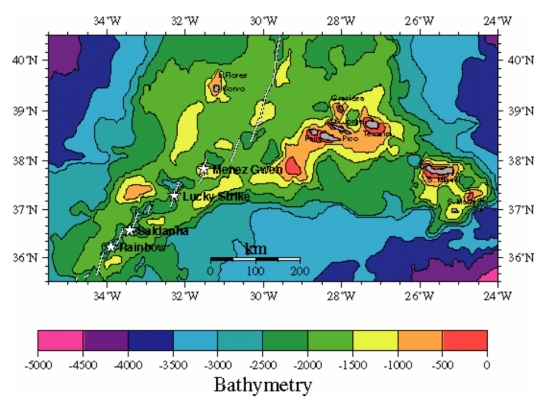Extensive description of site:
The MoMAR area, englobes the Menez Gwen, Lucky Strike, Saldanha, Menez Hom and Rainbow vent fields, and their
respective segments: the AMAR, FAMOUS, Lucky Strike and Menez Gwen segments. These segments trend subperpendicular
to the direction of plate separation and are offset by axial discontinuities. These discontinuities may be
transform faults, or so-called nontransform offsets. Tectonic and volcanic processes vary within each individual
segment: segments centers have a thicker crust, indicative of a larger supply of magma and enhanced volcanism,
while segments ends have a deeper axial valley, indicative of more pronounced tectonic activity. Menez Gwen and
Lucky Strike vent fields are on a basaltic environment at the center of the segment, while Saldanha and Rainbow are
in a Peridotite environment at the end of the segment. |
Habitats present:
| Deep-Sea Bed | Rock | Sand | Mud | Bioherm | Benthopelagic | Water Column |
| Continental Margin | | | | | | Epi-pelagic X |
| Abyssal Plain | | | | | | Mesopelagic X |
Seamounts and
Oceanic Islands flanks | X | X | | X | X | Bathypelagic X |
Chemosynthetic
environments | X | X | | X | X | Abyssopelagic X |
|
Description of fauna and flora:
The Mid-Atlantic Ridge sensu lato is a major source of energy and mineral flux into the surrounding ocean. As
hydrothermal vent systems (HTVs) are placed in an oligotrophic region, hydrothermal fluxes are likely to significantly
impact biogeochemical cycling and carbon flux. The vent fields are dominated by chemossynthetic bacteria which are
the base of the food chain. Extensive mussel beds of the mytilid Bathymodiolus azoricus (dominate the hydrothermal
vent fauna, as well as, populations of three bresilid shrimps (Chorocaris chacei, Mirocaris fortunata and Rimicaris
exoculata). Among the mussels, other invertebrates can be found such as pycnogonids, amphipods and other
polychaetes not commensal. Bathyal fauna can be observed around the vents, and some of it make incursions into the
vent fields. Normal deep-sea fauna as corals, sponges, anemones, alcyonairs, and ictiofauna can be observed on the
ridge flanks. |
Habitat description:
Habitats according to EUNIS classification:
A5.1; Deep-sea rock and artificial hard substrates
A5.2; Deep-sea combination substrates
A5.3; Deep-sea sand substrates
A5.6; Deep-sea bioherms
A6.2; Seamounts, knolls and banks
A6.3; Oceanic ridges
A6.5; Vents in the deep sea
A7; Pelagic water column
X30; Bentho-pelagic habitats |
Facilities:
The nearest harbour is located 150 miles away (Horta); an oceanographic vessel is therefore needed. R/V
“Arquipélago” is available to produce scientific work in the area (see specifications at:
http://www.horta.uac.pt/equipment/ships_1.html). Seasonal access to ROVs, manned submersibles and other
underwater instruments. Not easily accessible during winter. However, there are possibilities of good weather windows
during winter. If scientists are outside the Archipelago, there are flights from Lisbon to one of the islands and then a
research vessel to the sites. Good port facilities in at least three islands of the Archipelago: Faial; S. Miguel and
Terceira. From those ports, is possible to access the area if there is a need of submersibles (Manned submersibles
and/or ROVs). DOP-UAç laboratories (including LabHorta) might be used as a shore support base. |
Available database and website:
Time-series data:
There are some sporadic biodiversity data from the expeditions of Prince Albert of Monaco. Concerning the vent fields,
there are data since 1993, almost annually for some spots.
CD-rom available |
Commitment and ongoing research:
The area is being chosen for target studies for several research teams, from European countries and also from United
States, Russia and Japan. During the last ten years several International programs took place in the area. MARFLUX
(EC); AMORES (EC); VENTOX (EC); FARA (FR/USA/PT); and others non biological cruises. In the near future, two VI
framework programs are already accepted (EXOCET/D and MOMARNET). There are funds to study the MoMAR area:
EXOCET/D - EXtreme ecosystem studies in the Deep Ocean: Technological Developments (VI Framework EC)- Total
2.000.000€; MOMARNET- Monitoring deep seafloor hydrothermal environments on the Mid-Atlantic Ridge (VI
Framework EC) Total 2.620.720€. International geophysical teams are also studing the area (Ridge 2000 - USA,
slow ridge integrated site). |
Involvements:
|
Additional Information:
InterRidge Workshop: Long-Term MOnitoring of the Mid-Atlantic Ridge "MOMAR". In:
http://beaufix.ipgp.jussieu.fr/rech/lgm/MOMAR/MOMAR_WSR_1.pdf
Colaço, A., D. Desbruyères, T. Comtet & A. M. Alayse, 1998. Ecology of the Menez Gwen hydrothermal vent field (Mid-Atlantic Ridge/Azores Triple Junction). Cahiers de Biologie Marine 39: 237–240.
Desbruyères, D & Segonzac, M., 1997. Handbook of deep-sea hydrothermal vent fauna. 280pp Desbruyéres, D. Biscoito M., Caprais J.-C. , Colaço, A., Comtet, T.,Crassous, P., Fouquet, Y., Khripounoff, A., Le Bris, N., Olu, K., Riso R.,Sarradin, P.M., Segonzac, M., Vangriesheim, A., 2001.Variations in deep-sea hydrothermal vent communities on the Mid-Atlantic Ridge near the Azores plateau. Deep-Sea Research I 48: 1325-1346.
Santos, R.S., J. Escartín, A. Colaço & A. Adamczewska (eds). 2002. Towards planning of seafloor observatory programs for the MAR region (Proceedings of the II MoMAR Workshop). Arquipélago. Life and Marine Sciences. Supplement 3: XII + 64 pp.
Santos, R.S., Colaço, A. & Christiansen, S. (Eds) 2003 Planning the Management of Deep-Sea Hydrothermal Vent Fields MPA in the Azores Tripple Junction (Proceedings of the workshop) Arquipélago. Life and Marine Sciences. Supplement 4:xii +70pp.
Van Dover,C., Desbruyeres, D., Segonzac, M., Comtet, T., Saldanha, L., Fiala-Medioni, A. & Langmuir, C., 1996.
Biology of the Lucky Strike hydrothermal field. Deep-Sea Research I 43, (9): 1509-1529.
Van Dover, C. L., 1995. Ecology of Mid-Atlantic Ridge hydrothermal vents. In Parson, C. L. W. L. M. & D. R. Dixon (eds), Hydrothermal Vents and Processes. Geological Society Special Publication, London: 257–294. |




